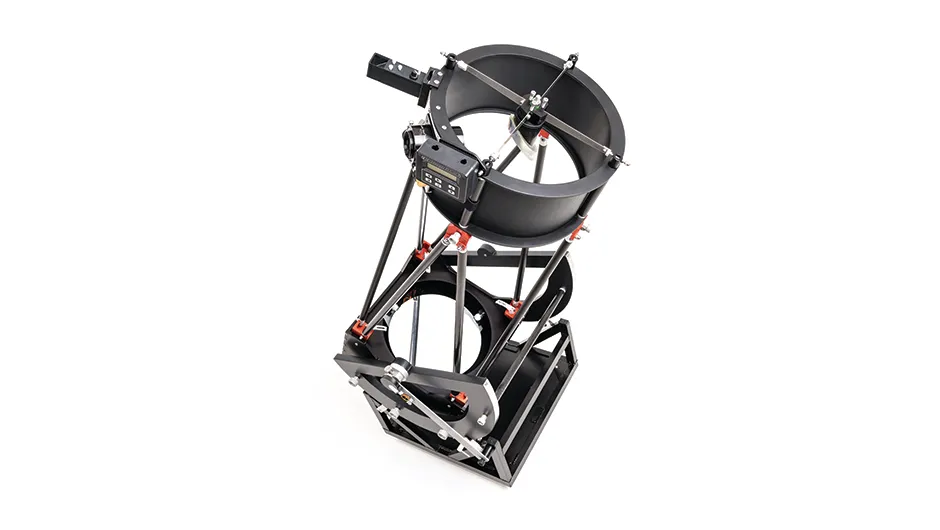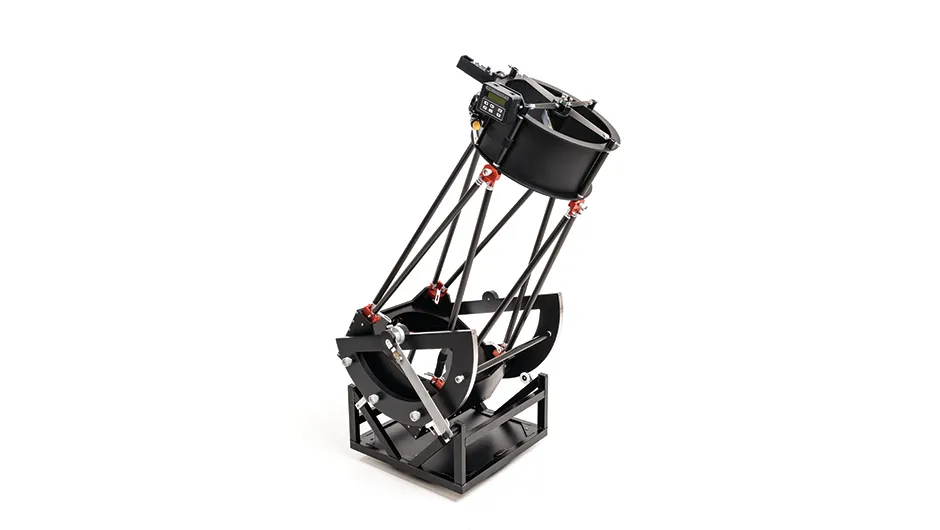French company SkyVision specialises in large, lightweight truss-design telescopes, including a range of portable Dobsonians.
This fine example is the 12-inch T300 Compact.
With a focal length of 1,200mm and a focal length of f/4, this is a very ‘fast’ system.
The primary mirror sits within the lower cage assembly in a nine-point flotation cell; on the underside of the assembly there are also three large collimation knobs, giving great control over the main mirror, a pair of fans to help bring it down to ambient temperature and three ‘phono’-style connectors for the fans and other accessories that require power.
A power supply is not provided – you’ll need a 12V battery with ‘spade’ connectors of the type commonly found in burglar alarm systems.
SkyVision has indicated that they are looking to provide a cable that will fit the powertanks often used by amateurs in the UK.
The upper cage houses the secondary mirror and spider vane assembly.

It is fitted with a low-profile Starlight FeatherTouch 2-inch focuser, which can also accommodate 1.25-inch eyepieces.
Also supplied is a Rigel Quickfinder: this zero-magnification finderscope worked well, but we found that it suffered a little from dew formation during prolonged observing sessions.
The truss assembly is an all-in-one unit made of carbon monobloc tubing that gives excellent support and stiffness to the secondary cage.
With quick-release fasteners it can be assembled and disassembled relatively easily (with a bit of practice) in the dark using a red light torch.
The cage containing the primary mirror has two D-shaped side bearings, which allow it to sit snugly on the sturdy and well-constructed rocker base.
In fact, everything about the scope’s construction exudes quality and it is a pleasure to behold.
We were also sent the optional Sky Commander digital setting circles and optical encoders.
This is a Push-To system rather than a motorised Go-To one.
Installing the encoders required minimal effort and once we’d performed the simple set up routine we found we could locate a wide range of objects with ease.
We can highly recommend this optional extra if your budget allows.
Exploring the sky
Aiming skywards we used our own 26mm eyepiece to gauge the field of view.
Despite the fast optics Capella, the alpha star in Auriga, was sharp across the central 80 per cent of the field of view; after this, some coma and chromatic aberration became evident.
Next up we were rewarded with lovely detailed views of the Orion Nebula, with its faint wisps of nebulosity sweeping away.
Swapping to our 9mm eyepiece, we explored the Trapezium Cluster within it, picking out two of the fainter stars designated ‘E’ and ‘F’.
We also split the tight triple star Iota Cassiopeia into its components with our 26mm eyepiece and 5x Powermate lens.

Galaxy hunting
Despite the temptation to linger on the likes of the Pleiades – which did indeed look gorgeous – the T300 Compact is a true deep-sky ‘bucket’, and so we went hunting for galaxies.
First we successfully picked out mag. +12.5 NGC 1924 in Orion.
Next we swung over to the region of the Beehive Cluster in Cancer and sought out nearby spiral galaxy IC 2390, a mag. +14.9 smudge that was just about visible with averted vision.
The Double Cluster in Perseus sparkled like diamonds on velvet, while early in the morning we caught several globular clusters, including M13.
Using our 9mm eyepiece we resolved myriad stars and even the dark propeller feature so often mentioned in astronomical guides – a truly terrific sight.
Finally we were rewarded with stunning views of the last quarter Moon and its craters, plus lots of detail on Jupiter.
It turns out even Solar System objects can be seen well in this large, short focal length Dobsonian.
The SkyVision T300 Compact is a well-designed system that we think will give many years of enjoyment of the night sky.
Truss
The truss pole assembly comes in one piece and concertinas out to form a strong yet lightweight support between the primary and secondary cages.
A pair of small green dots – one on the primary cage and another on one of the truss poles – allows for quick, reliable and consistent assembly.
Secondary cage
The upper cage is lightweight yet sturdy. It houses the flat secondary mirror, spider vane assembly, Starlight FeatherTouch focuser and the Rigel Quickfinder.
There is also a small velcro pad to allow you to attach a hand controller.
Collimation knobs
The knobs for collimating the primary mirror are often small and fiddly – not so here.
These ones are chunky, and as such it’s easy to make small adjustments.
Collimating the secondary mirror requires an Allen key, which is not provided, but is also a straightforward process.
Rocker box
The sturdy rocker box and turntable platform base are supplied as a single section.
The bearings give smooth movement when the main truss assembly is added and the altitude brake offers enough friction to prevent the telescope from drooping if you use heavy eyepieces.
Optics
The primary mirror is parabolic and has enhanced coatings for greater light transmission.
It is a ‘fast’ mirror of short focal length (f/4), giving bright crisp views of many deep-sky objects; it even allowed us to find galaxies as faint as mag. +15.0.
Vital stats
- Price: £5200.00
- Aperture: 300mm (12 inches)
- FocalLength: 1,200mm (f/4)
- Weight: 29.5kg
- Supplier: SkyVision
- Telephone: +33 547 772 345
- Website:www.skyvision.fr
This review originally appeared in the May 2014 issue of BBC Sky at Night Magazine.
